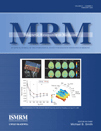Parallel spectroscopic imaging reconstruction with arbitrary trajectories using k-space sparse matrices
Abstract
Parallel imaging reconstruction has been successfully applied to magnetic resonance spectroscopic imaging (MRSI) to reduce scan times. For undersampled k-space data on a Cartesian grid, the reconstruction can be achieved in image domain using a sensitivity encoding (SENSE) algorithm for each spectral data point. Alternative methods for reconstruction with undersampled Cartesian k-space data are the SMASH and GRAPPA algorithms that do the reconstruction in the k-space domain. To reconstruct undersampled MRSI data with arbitrary k-space trajectories, image-domain-based iterative SENSE algorithm has been applied at the cost of long computing times. In this paper, a new k-space domain-based parallel spectroscopic imaging reconstruction with arbitrary k-space trajectories using k-space sparse matrices is applied to MRSI with spiral k-space trajectories. The algorithm achieves MRSI reconstruction with reduced memory requirements and computing times. The results are demonstrated in both phantom and in vivo studies. Spectroscopic images very similar to that reconstructed with fully sampled spiral k-space data are obtained at different reduction factors. Magn Reson Med 61:267–272, 2009. © 2009 Wiley-Liss, Inc.




